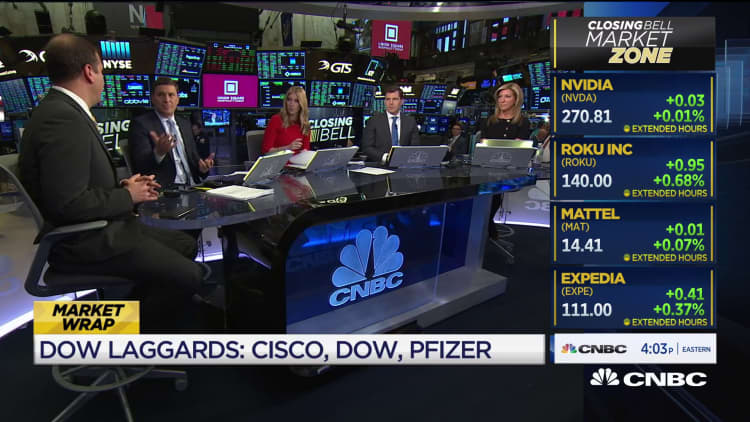
Stocks fell on Thursday, slipping from record highs, as investors grappled with a a jump in reported coronavirus cases and the virus' possible economic impact.
The Dow Jones Industrial Average slid by 128.11 points, or 0.4%, 29,423.31. The S&P 500 fell nearly 0.2% to 3,373.94 after notching an intraday record earlier in the session. The Nasdaq Composite closed 0.1% lower at 9,711.97. The tech-heavy index also hit an intraday all-time high before dropping into the close.
Microsoft shares fell about half a percent after to push the Dow lower. Cisco Systems, however, was the Dow's biggest decliner. The industrials sector dropped 0.7% and was the biggest laggard in the S&P 500. Health care also pulled back 0.5%.
United and American Airlines both fell more than 1%. Wynn Resorts and Las Vegas Sands — two proxy stocks for the coronavirus given their exposure to China — declined by more than 2% each.
China said it confirmed 15,152 new cases and 254 additional deaths. That brings the country's total death toll to 1,367 as the number of people infected jumped to nearly 60,000, according to the Chinese government.
The jump in cases was due to the way Chinese authorities are counting them. Health authorities in Hubei province said Thursday that they changed the way they tabulate case totals — "clinically diagnosed" cases now count toward the "confirmed case" count, resulting in the sudden surge among the latter.
Stocks have also fared better during the coronavirus outbreak than in other global medical emergencies.
"While China and travel-focused companies are obviously most vulnerable, as long as the economic impact on the U.S. economy remains modest expect U.S. equities to maintain their relative immunity to the virus," said Alec Young, managing director of global markets research at FTSE Russell. "Should that firewall begin to break, volatility is likely to increase significantly."
During the the SARS outbreak of the early 2000s, the S&P 500 lost nearly 13%. It also dropped nearly 6% during the Ebola outbreak in 2014. Thus far, the S&P 500 is actually up since the coronavirus outbreak. To be sure, some of those crises coincided with other events that also contributed to the broad index's decline.
"There is still hope in the market that the number of cases has stabilized to some degree," said Jon Adams, investment strategist at BMO Global Asset Management."But we do think this will continue to hang over the market."
There are concerns China may be under-reporting the number of coronavirus cases in its country. A senior Trump administration official told CNBC the U.S. does "not have high confidence in the information coming out of China." The official added China "continues to rebuff American offers of assistance."
Keith Buchanan, portfolio manager at GLOBALT, also noted the bond market has been more jittery about the coronavirus than the stock market.
"Traditionally, the fixed income market has been more accurate than equities predicting future growth. It's something to watch," Buchanan added. The 10-year Treasury yield has fallen to about 1.6% from 1.85% one month ago.
The major averages are coming off a record-setting session after notching all-time highs as investors tried to shrug off the uncertainty around the coronavirus. The Dow jumped more than 200 points on Wednesday while the S&P 500 and Nasdaq climbed 0.7% and 0.9%, respectively.
In corporate news, Cisco fell more than 5% after the company reported another decline in overall revenue. In the fourth quarter, Cisco's revenue dropped by 4% on a year-over-year basis. That decline overshadowed a better-than-expected profit.
PepsiCo, Alibaba and Applied Materials all reported quarterly earnings that beat expectations. Applied Materials shares gained 4.7%, but PepsiCo and Alibaba dropped 0.1% and 1.6%, respectively.
On the data front, weekly jobless claims rose marginally, but remained near multi-decade lows. The latest read on the U.S. Consumer Price Index — a widely followed measure of inflation — rose 2.5% on a year-over-year basis.
—CNBC's Holly Ellyatt contributed to this report.


